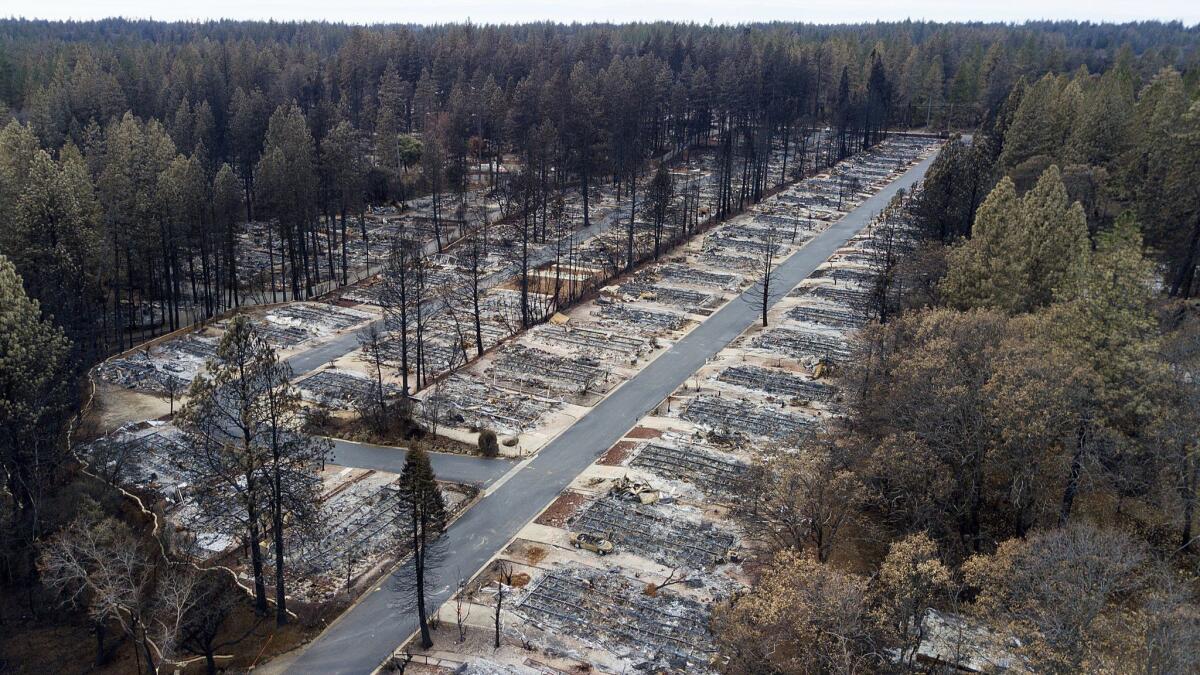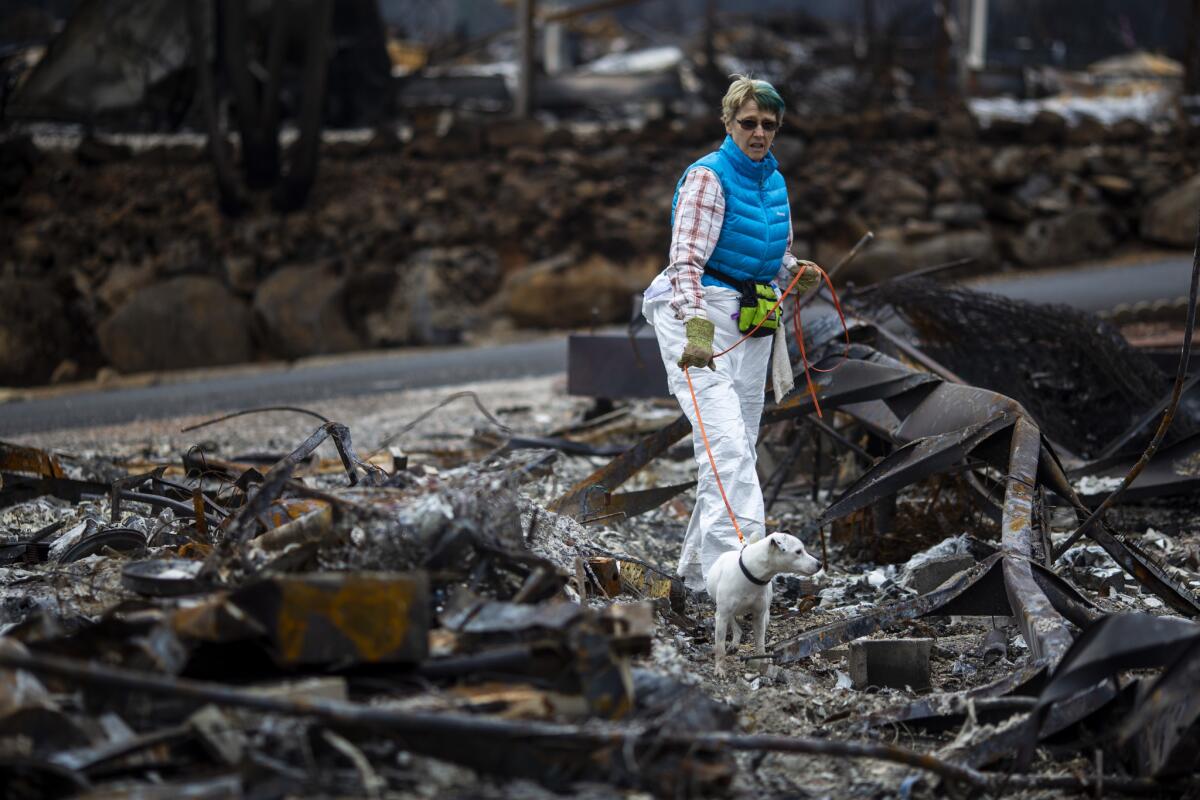Must Reads: Poor, elderly and too frail to escape: Paradise fire killed the most vulnerable residents

Reporting from PARADISE, Calif. — Dorothy Mack had crippling back pain and deteriorating eyesight. Helen Pace used a walker and could barely hear. Teresa Ammons suffered a stroke in 2017 and couldn’t drive.
Although each woman had a different frailty, their final circumstances were strikingly similar: They were all seniors on fixed incomes, they all lived alone, and they all died when the Camp fire roared through their mobile home park.
Experts say the incineration of Paradise, a sleepy town of 27,000 nestled in the foothills of the Sierra Nevada, is a case study in what can go wrong when a landscape that’s prone to wildfire is disproportionately populated by those who are least likely to escape.
Like the women who died in Ridgewood Mobile Home Park, most of the 86 people who died in the fire were seniors. Of the 69 bodies that have been positively identified, 53 were over the age of 65 — or 77%.
This grim fact comes as no surprise to those who study the impacts of wildfire.

The U.S. Fire Administration estimates that older adults are more than twice as likely than the general population to die in fires. And a quarter of Paradise residents had a disability, which is more than double the statewide rate.
Decades of research confirm that the physical limitations that accompany advanced age make it much more difficult to escape disaster, but so do the social isolation and stubbornness that experts say are common among the elderly.
And when poverty accompanies old age — as it did for many in Paradise, an affordable retirement enclave in a region gripped by a housing crisis — the risk of death is compounded.
Now, as planning and policy officials attempt to draw lessons from the extreme loss of life and property in Paradise and surrounding Butte County towns, advocates say that emergency preparedness needs to be expanded in a way that addresses issues specific to those seniors who are drawn to live in areas of high fire risk.
“We have to fundamentally change our approach to emergency management,” said L. Vance Taylor, chief of the Office of Access and Functional Needs at the Governor’s Office of Emergency Services. “The old way isn’t enough to meet this new normal, this new dynamic.”
When the Camp fire marched through Paradise last fall, an estimated 25 percent of Paradise-area residents were 65 or older, according to the latest U.S. Census Bureau estimates. That compares with 14 percent statewide.
The city had long attracted retirees with limited incomes seeking picturesque surroundings. Many lived in retirement communities such as Ridgewood, a quiet and clean mobile home park surrounded by pine trees.
Some people moved there for the community, said Cathy King, who managed the park from 2014 to the summer of 2018. But most made the choice out of necessity.
That was the case for 68-year-old King, at least.
“You know they aren’t as well made,” King said of mobile homes. “But at the end of the day, you find a place you can afford and hope for the best.”
According to fire officials, mobile homes — particularly those built before tougher building regulations were enacted in 1976 — burn faster due to the materials they’re made from, like aluminum and particle board. And mobile homes in parks have little space between them, making it easy for flames to jump from one dwelling to another.
Of the 53 seniors who have so far been identified as having died in the Camp fire, at least 22 lived in mobile or manufactured homes.
As the Camp fire raced toward the retirement community, some residents had their friends in mind as they fled. Residents blared their horns, knocked on doors and offered rides to those who couldn’t drive. They convinced their more stubborn neighbors that this was, in fact, a matter of life or death.
Mack, 88, Pace, 84, and Ammons, 82, didn’t make it out.
No one knows for sure why the women didn’t leave, but family members and King have theories: Mack liked to sleep in, and she may have still been in bed when fire engulfed the park. Ammons was a recluse who usually wouldn’t answer the door, and she didn’t drive. Her remains were found a couple feet from her doorstep.
It is also possible that because all three of these women spent most of their time alone, they may not have received the second or third door knocks from friends that might have provoked them to leave.
“There were a lot of close relationships in the park,” King said. “Those particular women didn’t have them.”
When people are socially isolated — as many elderly and disabled are — they are more likely to get left behind, experts say.
Yet, if there’s a greater feeling of unity within a neighborhood, seniors are less likely to experience the negative health impacts of isolation during a crisis, said Allison Heid, an independent research consultant who studies adult development and aging.
“Having a network and having resources for their physical, mental and social health, makes all the difference in a disaster,” she said.
This means the most vulnerable must be actively sought out before, during and after the onset of a disaster, Taylor said.
Local governments could help facilitate such networks through a buddy system program, Taylor said. Able-bodied residents might volunteer to assist someone who is likely to need help in an emergency.
A state law passed in 2016 requires each county to consider access and functional needs in its evacuation plan. The law does not specify, however, how in-depth those efforts should be or how much money should be spent on them.
In Butte County, this took the form of the Special Needs Awareness Program, or SNAP, first developed by the town of Paradise and adopted by the county in 2008.
Butte County’s sheriff’s office has access to a map that plots the addresses of SNAP participants — 4,000 at the time of the Camp fire, according to officials. In an ideal scenario, the map could be used to deploy resources to the county’s most vulnerable residents first, said Cindi Dunsmoor, who leads the Butte County’s Office of Emergency Management.
As it stands, the county’s evacuation plans are not tailored in any way to the SNAP database. In practice, SNAP was more about “helping residents to learn to help themselves,” Dunsmoor said, such as making sure they knew who to contact in an emergency.
“We make it very clear that this is not a guarantee that you will be picked up,” said Dunsmoor, who added that the county is in the process of reevaluating its evacuation plan.
Participants were also given reflective signs to put in their windows to indicate that they need extra help during an emergency. No one interviewed for this article had heard of anyone using the signs during the Camp fire.
Deploying help to a registry of vulnerable people during a disaster is not realistic for most communities, Taylor said. “I don’t think you can keep that list current or get everyone to sign up,” said Taylor, who has muscular dystrophy and uses a power wheelchair.
There is also the matter of money. Disaster planning remains a local responsibility, and formulating a robust strategy for saving lives can come at a huge expense for counties on shoestring budgets.
Take Lake County, where in 2015 the Valley fire killed four people, all over the age of 65. Since then, the county has upgraded its emergency notification system, revised its evacuation plan and formed a multi-agency disaster council. County response is now more nimble overall during wildfires, said Dale Carnathan, head of the Lake County Sheriff’s Office of Emergency Services.
But officials there have not considered a registry similar to SNAP for the simple reason that it cannot afford it. Sixty-five percent of the county’s land mass has been burned over the past three years, Carnathan said. Thousands of homes have been destroyed. And the tax base has suffered as a result.
“I’d love to be able to send a SWAT team of first responders into a retirement community,” Carnathan said. “But I just can’t do it.”
What local governments of all sizes can do, and should do, is promote personal preparedness, experts say.
“There really should be a massive education program to educate every baby boomer about the risk of fire where they live,” said Elaine Wethington, a gerontology professor at Cornell Medical School.
Personal preparedness doesn’t amount to much, though, when seniors aren’t notified of a fire. Butte County sent emergency cellphone calls and texts asking residents to evacuate, but many people hadn’t signed up for the service, including some seniors without cellphones. Ideally, several channels of communication should be used to deliver notifications — including TV and radio — so that those who have difficulty seeing and hearing will be alerted, Wethington said.
But even when informed of a threat, some seniors find it difficult to leave.
Sisters Barbara Carlson, 71, and Shirley Haley, 67, lived together in a Paradise mobile home. The streets were jammed by the time Carlson’s granddaughter, Maggie Masterson, called their landline to tell them that the town was being evacuated.
Before the line suddenly cut out, the sisters seemed reluctant to abandon their home.
“They were very stubborn people,” Masterson said.
Many family members of those killed in the Camp fire described those they lost in a similar way. This makes sense to Allison Heid, who has researched stubbornness in aging adults. In one study, she found that up to 70 percent of children of seniors saw their parents as stubborn, a perceived characteristic that can become more pronounced in a crisis.
Wethington has theories for why this might be the case. Older adults may hesitate to leave their properties because they don’t have much time left to rebuild a life. And evacuation orders are easier for them to discount because they’ve already survived so many warnings.
Understanding the way seniors process and react to wildfires is key to protecting them, Taylor said. It’s why disaster plans should ultimately be informed by a diverse set of stakeholders, including the old, the disabled and the economically disadvantaged.
“It’s something I’ll ask again and again,” Taylor said. “Who’s at your planning table?”
[email protected] | Twitter: @LauraMNewberry
More to Read
Sign up for Essential California
The most important California stories and recommendations in your inbox every morning.
You may occasionally receive promotional content from the Los Angeles Times.











